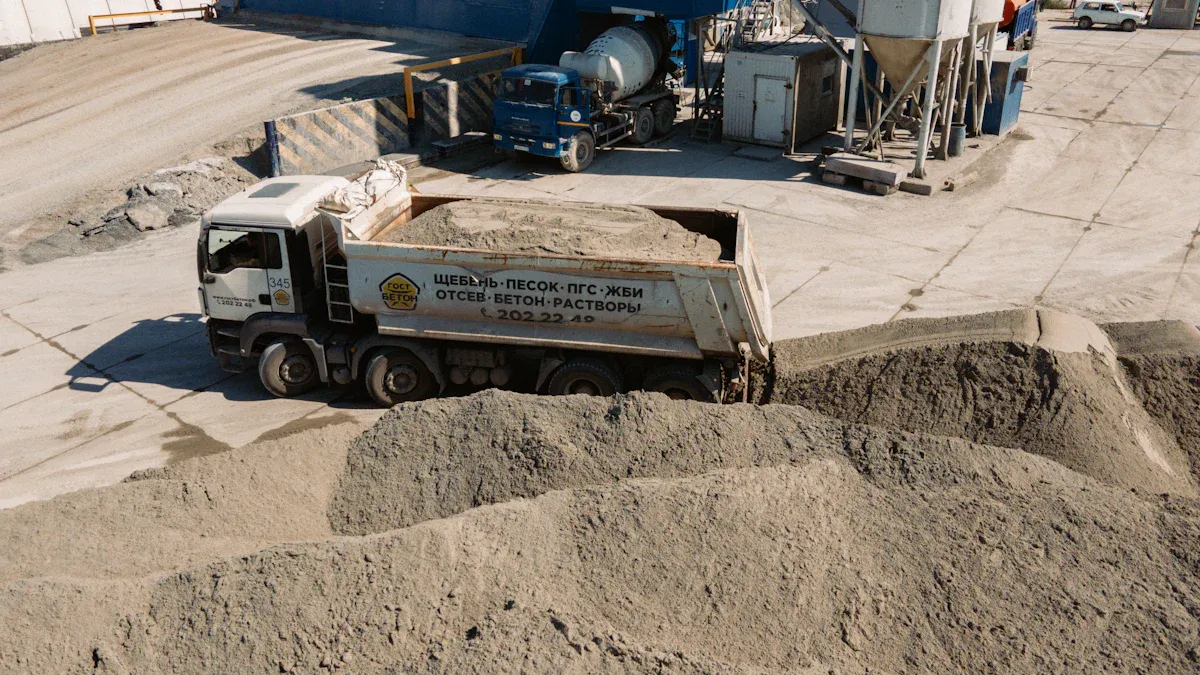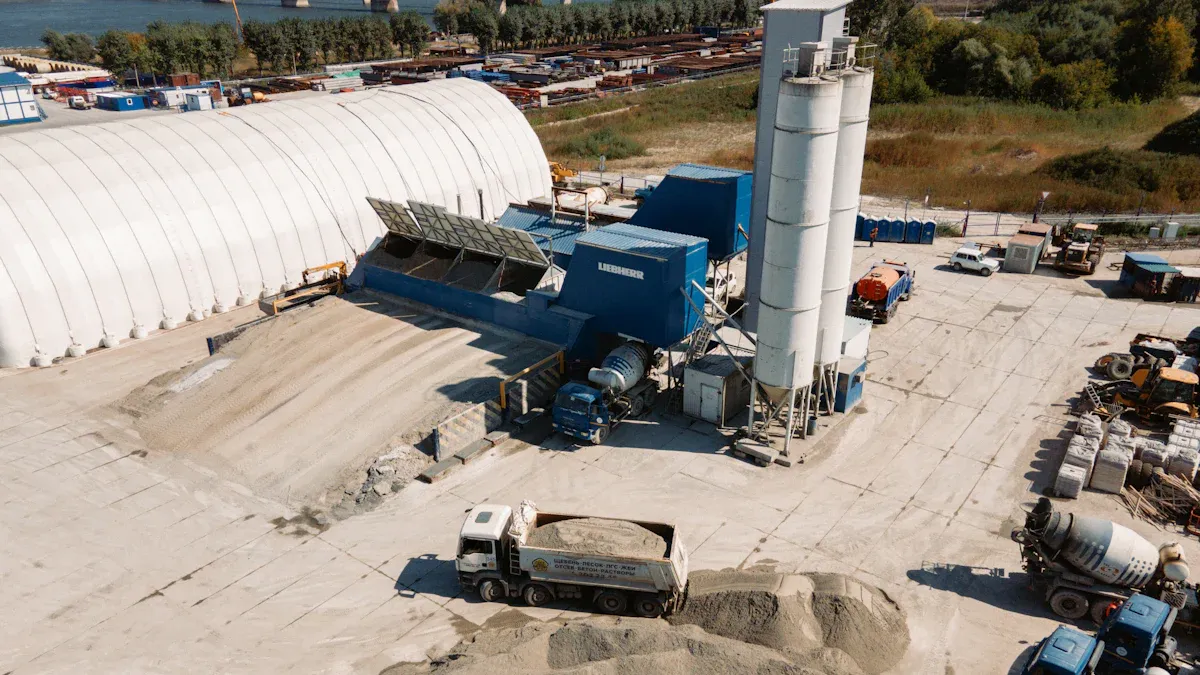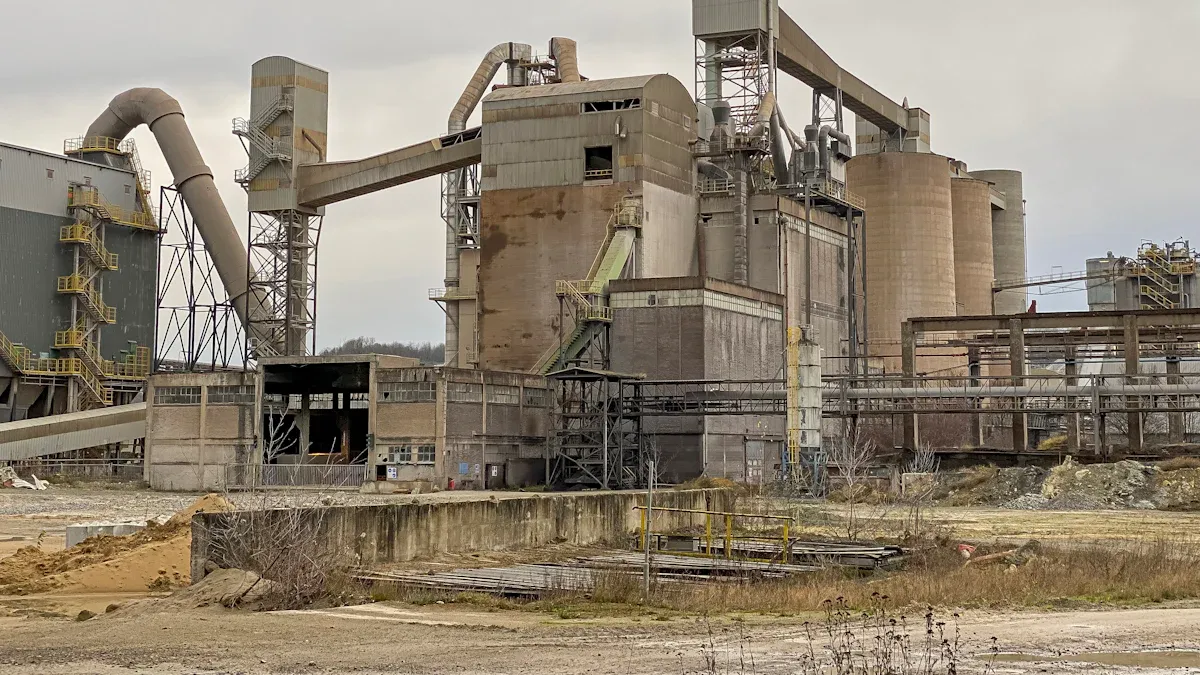
Wear-resistant liners play a vital role in keeping your concrete mixing plant running smoothly. These liners shield equipment from abrasion caused by constant material movement, significantly extending their lifespan. This minimizes the need for frequent repairs and replacements, saving you both time and money.
By reducing wear on critical components, wear-resistant liners enhance operational efficiency in concrete plants. For example:
- They protect sealing systems from heavy material loads, reducing interruptions in workflow.
- Their durability shortens maintenance schedules, allowing projects to move faster and with fewer delays.
Investing in wear-resistant liners ensures your plant operates efficiently while lowering overall maintenance costs.
Wear-resistant liners are protective layers designed to shield equipment from damage caused by constant friction, impact, and material movement. In concrete plants, these liners act as a barrier between abrasive materials and the equipment's surface. This reduces wear and tear, ensuring your machinery lasts longer and operates efficiently.
These liners are essential in environments where materials like sand, gravel, and cement create significant abrasion. By using wear-resistant solutions, you can minimize equipment degradation and lower maintenance costs.
The materials used in wear-resistant liners vary depending on the application. Common options include:
- Alumina-based ceramics: These liners are modular, making them easy to install and replace. They also offer excellent resistance to wear and thermal shock.
- Silicon carbide ceramics: Known for their exceptional hardness, these liners perform well in high-temperature and corrosive environments.
- Wear-resistant alloy steels: These materials combine strength and durability, making them ideal for heavy-duty applications.
Research shows that new wear-resistant materials outperform traditional options like 16 Mn steel and ordinary carbon structural steel. For example, the wear thickness of 16 Mn steel is over 12 times greater than that of advanced wear-resistant materials. This highlights the superior durability of modern wear treatment technologies.
Wear-resistant liners are specifically engineered to handle abrasive applications. Their robust construction absorbs the impact of heavy materials, preventing damage to equipment surfaces. For instance, silicon carbide liners excel in harsh conditions, offering unmatched resistance to wear and thermal stress.
These liners also utilize advanced wearfacing technologies to enhance their durability. By incorporating specialized coatings and materials, they provide long-lasting protection against abrasion. This ensures your concrete plant operates smoothly, even under demanding conditions.

Wear-resistant liners are designed to endure the harsh conditions of a concrete mixing plant. These liners resist abrasion caused by the constant movement of materials like sand, gravel, and cement. Their durability ensures that critical components remain protected, even under heavy use.
For example, tests such as the ASTM D4966-22 evaluate the abrasion resistance of materials. These tests measure material loss, visible wear, and performance against industry standards. Liners that pass these tests demonstrate their ability to withstand high-abrasion conditions. This means you can rely on them to provide consistent protection and reduce the need for frequent replacements.
By incorporating advanced wearfacing technologies, modern liners offer high protection against wear. This innovation enhances their ability to combat the damaging effects of friction and impact, ensuring your equipment stays in top condition.
Concrete mixing plants operate in demanding environments where equipment faces constant stress. Wear-resistant liners are engineered to last longer in these conditions, reducing the frequency of maintenance. Their extended lifespan directly translates to lower operational costs and improved efficiency.
Case studies highlight the impressive longevity of these liners. For instance:
- Tega's DynaPrime® Composite Liner has shown significant improvements in lifespan, leading to energy savings of up to 7000 MWh per year in large ball mills.
- Optimized mill linings at TISCO increased wear life by 36%, extending the service life of shell linings from 70 days to 75 days.
These examples demonstrate how wear-resistant liners can handle high-stress environments while maintaining their performance. By investing in these solutions, you can ensure your equipment remains operational for longer periods.
Wear-resistant liners are designed to integrate seamlessly with the components of a concrete mixing plant. Whether protecting hoppers, chutes, or mixing drums, these liners fit perfectly to provide maximum coverage. Their compatibility ensures that every part of your equipment receives the protection it needs.
The materials used in these liners, such as alumina-based ceramics and wear-resistant alloy steels, are chosen for their adaptability. They can be customized to match the specific requirements of your plant, ensuring optimal performance. This flexibility makes them a valuable addition to any concrete mixing operation.
By choosing liners that align with your plant's components, you can enhance the overall efficiency of your operations. Properly installed liners not only protect your equipment but also contribute to smoother workflows and reduced downtime.

Hoppers and bins in concrete plants endure constant abrasion from materials like sand, gravel, and cement. Wear-resistant liners act as a protective lining, shielding these components from damage. Polyurea and polyurethane coatings, for example, create a sacrificial layer that absorbs wear. These coatings can be applied in thicknesses ranging from 1/8 inch to several inches, offering superior protection.
| Feature | Description |
|---|---|
| Coating Types | Polyurea and polyurethane coatings provide a sacrificial layer for protection against wear. |
| Applications | Suitable for various surfaces including metal, fiberglass, and wood, applicable to hoppers and bins. |
| Thickness | Can be applied from 1/8" to multiple inches thick, offering superior protection. |
| Maintenance Benefits | Designed to reduce maintenance costs and maximize equipment return on investment. |
| Environmental Resistance | Provides protection from harsh chemicals and biological environments. |
By reducing wear, these liners minimize maintenance needs and extend the lifespan of hoppers and bins, ensuring your equipment remains operational for longer periods.
Mixing drums and paddles face constant stress from the abrasive nature of concrete materials. Wear-resistant liners significantly enhance their durability, reducing the frequency of repairs. Studies show that liners made from austenitic manganese steel last five to six times longer than unprotected surfaces. At TISCO Yuanjiacun Iron Mine, optimized metallic mill linings extended the service life of feed head liners to 65 days, compared to 60 days with other brands.
Tega's DynaPrime composite liner also demonstrates exceptional performance. By integrating advanced manufacturing technologies, it extends the lifespan of mixing components, reducing operational costs and improving equipment availability. With these liners, you can ensure your mixing equipment operates efficiently and reliably.
Chutes and conveyors are critical for transporting materials in concrete plants. Without proper protection, these components can suffer from severe abrasion and impact damage. Wear-resistant liners, such as ceramic chute liners, provide a robust solution. These liners can extend equipment lifespan by 10 to 20 times compared to traditional materials.
RockPlate liners have a service life of four years, far exceeding the 3-4 months typical of AR Steel liners.
Ceramic liners offer unmatched resistance to abrasiveness, ensuring long-term durability.
Selecting the right liner based on material abrasiveness reduces maintenance costs and enhances equipment longevity.
By preventing damage, these liners keep your chutes and conveyors running smoothly, reducing downtime and improving overall plant efficiency.
Wear-resistant liners significantly reduce the time your equipment spends offline. By protecting critical components from wear and tear, these liners extend the lifespan of your machinery. For example:
- In a large run-of-mine mill, wear-resistant liners lasted five to six times longer than unprotected liners. This improvement saved up to 100 hours of downtime annually.
- High-chromium white iron liners demonstrated exceptional durability, reducing the need for frequent maintenance.
Monitoring liner wear and optimizing their design can further enhance performance. This approach ensures that each component lasts as long as possible, minimizing interruptions in your concrete mixing plant. With less downtime, you can maintain a steady workflow and meet project deadlines more efficiently.
Investing in wear-resistant liners leads to substantial cost savings. These liners reduce the frequency of repairs and replacements, cutting down on material and labor expenses. A cost analysis revealed the following:
| Description | Savings | Duration Change |
|---|---|---|
| Annual ceramic-epoxy costs reduction | 35% | From 6 weekly changes to 34 weeks without change |
This data highlights the financial benefits of using durable liners. By extending the time between replacements, you can allocate resources to other areas of your operation. Over time, these savings add up, making wear-resistant liners a cost-effective solution for concrete plants.
Wear-resistant liners enhance the overall efficiency of your concrete mixing plant. By reducing equipment wear, they ensure that your machinery operates at peak performance. This improvement directly impacts productivity. For instance:
- The steel wear liners market, valued at USD 350.6 million in 2023, reflects the growing demand for components that boost equipment efficiency.
- Industries like construction and manufacturing rely on wear-resistant liners to maintain operational efficiency, especially in high-stress environments.
The increasing complexity of infrastructure projects further underscores the importance of durable liners. These projects demand reliable equipment that can handle heavy workloads without frequent maintenance. By using wear-resistant liners, you can meet these demands while improving the productivity of your concrete plant.
One of the most practical advantages of wear-resistant liners is their ease of installation and replacement. Manufacturers design these liners with user convenience in mind, ensuring that you can quickly install or replace them without disrupting your operations for long periods.
Modular Design: Many wear-resistant liners come in modular sections. This design allows you to replace only the worn-out parts instead of the entire liner, saving time and resources.
Lightweight Materials: Some liners, such as those made from polyurethane or composite materials, are lightweight. This makes handling and positioning them much easier during installation.
Pre-drilled Holes and Fasteners: Liners often include pre-drilled holes and compatible fasteners. These features ensure a secure fit and reduce the need for additional tools or adjustments.
Tip: Always follow the manufacturer's guidelines during installation. Proper alignment and secure fastening can maximize the liner's lifespan and performance.
Replacing wear-resistant liners is a straightforward process. You can often complete the task with minimal downtime, ensuring your plant remains productive. Here’s how liners simplify the replacement process:
Quick Removal: Modular liners can be detached easily, often without requiring specialized equipment.
Standardized Sizes: Many liners are available in standardized sizes, making it easier to find replacements that fit your equipment perfectly.
Reduced Labor Requirements: Lightweight and modular designs reduce the need for large teams or heavy machinery during replacement.
| Feature | Benefit |
|---|---|
| Modular Design | Replace only damaged sections, saving time and money. |
| Lightweight Materials | Simplifies handling and reduces the risk of injury during replacement. |
| Standardized Sizes | Ensures compatibility with most concrete plant components. |
Efficient installation and replacement processes directly impact your plant's productivity. When you can quickly install or replace liners, you minimize downtime and keep your operations running smoothly. This efficiency also reduces labor costs and ensures your equipment remains protected without lengthy interruptions.
Note: Regular inspections can help you identify wear early. Replacing liners before they fail completely can prevent costly damage to your equipment.
By choosing wear-resistant liners designed for easy installation and replacement, you can save time, reduce costs, and maintain a high level of operational efficiency. These practical benefits make them an essential investment for any concrete mixing plant.
Selecting the right wear-resistant liner for your concrete plant requires careful evaluation of material type and application. Each material offers unique advantages based on specific needs:
- Steel liners: High-chrome steel provides excellent wear resistance, making it ideal for abrasive tasks. Cold roll steel balances cost and performance in high-impact areas.
- Rubber liners: These excel in impact resistance and noise reduction, offering protection for components like mill shells.
- Ceramic and composite liners: These materials deliver superior hardness and durability, perfect for high-abrasion environments.
You should also consider the liner's profile design. Adjusting thickness can prevent rapid wear or inefficiencies. Regular monitoring of wear and operating conditions ensures optimal performance and helps identify potential issues early.
Collaborating with manufacturers or industry experts can help you make informed decisions. Experts provide tailored solutions that maximize protection for critical areas like mill feed chutes and transfer chutes. For example:
| Benefit Description | Source |
|---|---|
| Optimized solutions for various applications provide maximum protection. | Metso |
| Tailored material and desi gn selection enhance performance. | Metso |
| Continuous collaboration improves performance and sustainability. | Metso |
Investing in premium liners through expert consultation can extend equipment lifespan, reduce downtime, and lower overall costs. This approach ensures you get a custom liner solution that meets your plant's specific needs.
Proper installation and maintenance are essential for maximizing the lifespan of wear-resistant liners. Start by ensuring surface preparation meets industry standards, such as NACE 2/SSPC SP101 cleanliness levels. Control environmental conditions like humidity and temperature during application to prevent issues like rust bloom.
Regular inspections after installation help identify defects and maintain the liner's integrity. Establishing quality control checkpoints during application ensures compliance with specifications. These practices not only enhance the liner's performance but also reduce the risk of unexpected failures.
By following these steps, you can ensure your wear-resistant liners deliver long-lasting protection and efficiency for your concrete plant.
Wear-resistant liners play a crucial role in reducing maintenance and improving the efficiency of concrete plants. By protecting equipment from abrasion and impact, these liners extend the lifespan of critical components and minimize downtime. This leads to significant cost savings and ensures your plant operates a t peak performance.
Investing in wear-resistant liners offers long-term benefits. You save money on repairs and replacements while enhancing the durability of your equipment. These liners are a smart choice for maintaining the productivity and reliability of your concrete plants.
Tip: Consult with industry experts to select the best liners for your specific needs and ensure proper installation for maximum effectiveness.
Wear-resistant liners protect equipment from abrasion and impact. They reduce maintenance needs, extend equipment lifespan, and improve operational efficiency. By minimizing downtime, these liners help you save money and keep your plant running smoothly.
Inspect liners regularly for visible wear, cracks, or thinning. If you notice reduced performance or increased equipment damage, it’s time to replace them. Early replacement prevents costly repairs and ensures consistent protection.
Yes, manufacturers design liners to fit various components like hoppers, chutes, and mixing drums. Customizable options ensure compatibility with your specific equipment, providing maximum protection and efficiency.
No, most liners feature modular designs, pre-drilled holes, and lightweight materials. These features make installation and replacement quick and straightforward, minimizing downtime and labor costs.
Consider your plant’s specific needs. For high abrasion, ceramic or composite liners work best. For impact resistance, rubber or steel liners are ideal. Consult with experts to select the most suitable material for your application.
Tip: Regular maintenance and proper installation maximize the performance and lifespan of wear-resistant liners.